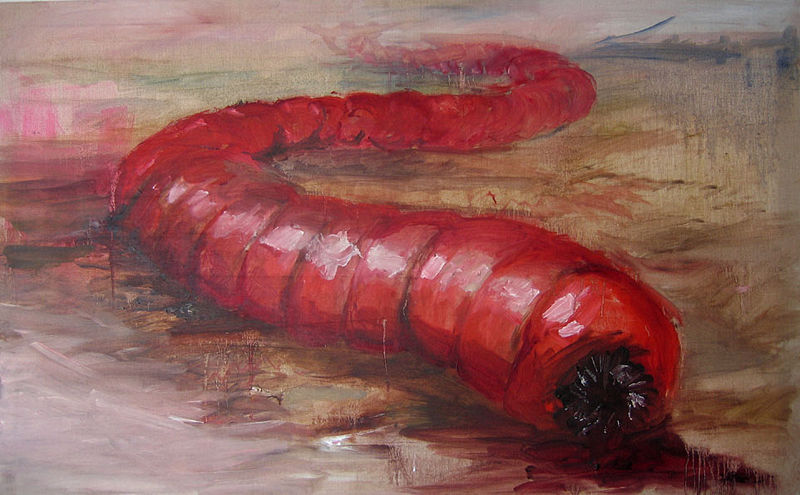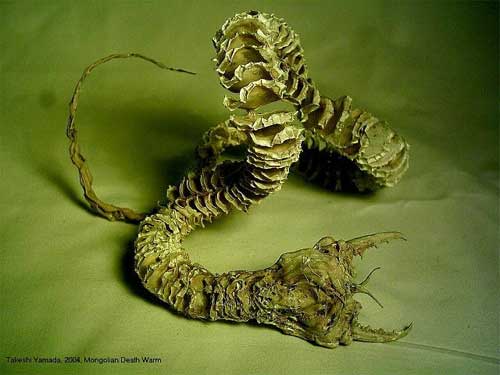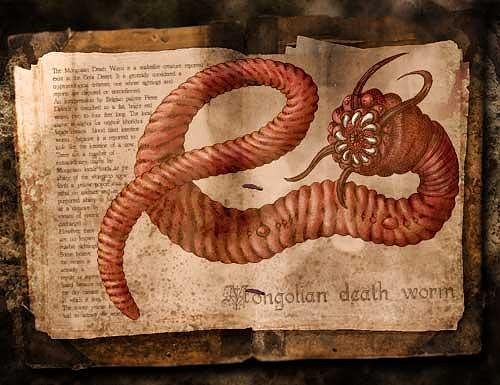|
|
||
|
..
Journalist
hunts for acid-spitting
Mongolian death worm
* Hunt for
mysterious death worm
ARMED with explosives, two men are heading to Mongolia's desert to find the fabled acid-spitting and lightning-throwing Mongolian death worm. The worm- allegedly found in the country's Gobi Desert- has never been documented but locals strongly believe it exists. The worm- about 1.5m long- apparently jumps out of the sand and kills people by spitting concentrated acid or shooting lightning from its rectum over long distances. New Zealand resident and journalist David Farrier will spend two weeks trying to verify the worm's existence. He and cameraman Christie Douglas will make a documentary about their adventure. Farrier said it was also one of the mythical creatures that had a better chance of being real. He said he was interested in the death worm because it was one of the most outrageous creatures that were rumoured to exist. Rumours could inflate the reputation of things such as the Loch Ness monster and Bigfoot, but sparsely populated Mongolia was not a place where rumours were going to propagate, Farrier said. "If a Mongolian says they have seen a big worm-like creature out in the desert they haven't really got any reason to lie," he said. A number of experts have dismissed the worm's existence, putting it down as a rumour. "I think it won't be a worm, obviously a worm can't survive in a desert. I'd say it would be some sort of snake that's not meant to be there. It's very out of place and a bit new,'' Farrier said. Farrier said there been up to four unsuccessful expeditions searching for the death worm in the last 100 years, which had used night vision goggles to look for the worm. However, the New Zealand team planned to bring the worm to the surface with explosives, as it is said to be attracted to tremors. Farrier put his chances of finding the worm at between 5 and 15 per cent. "They are high for a ridiculous creature like the death worm but the area I am going to is a very specific place in the southern Gobi where all the sightings have been," he said. "I have no intention of grabbing it, capturing it, stuffing it, or anything like that. I just want to prove its existence and if I can get it on film, that's all I need to do." SOURCE: News Australia |
||
|
..
The Mongolian Death Worm is a cryptid purported to exist in the Gobi Desert. It is generally considered a cryptozoological creature; one whose sightings and reports are disputed or unconfirmed. It is described as a bright red worm with a wide body that is 0.6 to 1.5 meters (2 to 5 feet) long. In general, scientists reject the possibility that such mega-fauna cryptids exist, because of the improbably large numbers necessary to maintain a breeding population[1] and because climate and food supply issues make their survival in reported habitats unlikely. The local name is allghoi, which means "blood filled intestine worm" because it is reported to look like the intestine of a cow. It is the subject of a number of extraordinary claims by Mongolian locals—such as the ability of the worm to spew forth sulfuric acid that, on contact, will turn anything it touches yellow and corroded (which would kill a human), and its purported ability to kill at a distance by means of electric discharge. The Mongolian Death Worm, known to Mongolias nomadic tribesmen as the allghoi khorkhoi (sometimes given as allerghoi horhai or olgoj chorchoj) or intestine worm for its resemblance to a sort of living cows intestine. It is said to be red in colour, and is sometimes described as having darker spots or blotches, and sometimes said to bear spiked projections at both ends. They are said to be thick bodied and between 2 and 5 feet long. The Mongolian Death Worm is said to inhabit the Southern Gobi Desert in Mongolia. The first reference in English to this remarkable beast appears in Professor Roy Chapman Andrews 1926 book On the Trail of Ancient Man, although the American palontologist (apparently the inspiration for the Indiana Jones character) was not entirely convinced by the tales of the monster he heard at a gathering of Mongolian officials: None of those present ever had seen the creature, but they all firmly believed in its existence and described it minutely. Czech Explorer Ivan Mackerle: "Sausage-like worm over half a metre (20 inches) long, and thick as a mans arm, resembling the intestine of cattle. Its tail is short, as [if] it were cut off, but not tapered. It is difficult to tell its head from its tail because it has no visible eyes, nostrils or mouth. Its colour is dark red, like blood or salami It moves in odd ways either it rolls around or squirms sideways, sweeping its way about. It lives in desolate sand dunes and in the hot valleys of the Gobi desert with saxaul plants underground. It is possible to see it only during the hottest months of the year, June and July; later it burrows into the sand and sleeps. It gets out on the ground mainly after the rain, when the ground is wet. It is dangerous, because it can kill people and animals instantly at a range of several metres."
The creature is reported to be able to spray an acid like substance that causes death instantly. It is also claimed that this creature has the ability to kill from a distance with some sort of super charged electrical charge. Numerous Mongolians have reported seeing this creature including a Mongolian Premier. The creature is reported to hibernate during most of the year except for June and July when it becomes active. It is believed that touching any part of the worm will bring instant death, and its venom supposedly corrodes metal. Local folklore also tells of a predilection for the color yellow and local parasitic plants such as the Goyo. It is also believed that the worm likes to get out on the ground generally after the rain, when the ground is still wet. David Farrier to embark on hunt for Mongolian death worm Two New Zealanders will leave for Mongolia's Gobi Desert next week on an ambitious expedition to find the fabled acid-spitting and lightning-throwing Mongolian death worm. The worm has never been documented but some Mongolians are convinced it exists. They call it Allghoi Khorkhoi, or "intestine worm" because it resembles a cow's intestine and is about 1.5m long. They say it jumps out of the sand and kills people by spitting concentrated acid or shooting lightning from its rectum over long distances. Auckland-based journalist David Farrier, who is organising the expedition, and Motueka-based cameraman Christie Douglas, leave on Tuesday to spend two weeks in the Gobi, trying to verify the worm's existence and making a documentary about it. They will hire local Mongolians to help them; a guide, translator and cook. Farrier, who works for TV3, told NZPA he had always been fascinated by cryptozoology, or the search for hidden creatures. The expedition and documentary, which would cost him between $15,000 and $20,000, would take a serious look at the worm and what it was, Farrier said. He said he was interested in the death worm because it was one of the most outrageous creatures that were rumoured to exist. However, it was also one of the mythical creatures that had a better chance of being real. Rumours could inflate the reputation of things such as the Loch Ness monster and Bigfoot, but sparsely populated Mongolia was not a place where rumours were going to propagate, Farrier said. "If a Mongolian says they have seen a big worm-like creature out in the desert they haven't really got any reason to lie." A number of experts have dismissed the worm's existence, putting it down as a rumour, but Farrier was not put off. "I think it won't be a worm, obviously a worm can't survive in a desert. I'd say it would be some sort of snake that's not meant to be there. It's very out of place and a bit new." Farrier said there been up to four unsuccessful expeditions searching for the death worm in the last 100 years, the last two in 2003 and 2005, which had used night vision goggles to look for the worm. However, the New Zealand team planned to bring the worm to the surface with explosives, as it is said to be attracted to tremors. Farrier put his chances of finding the worm at between 5 and 15 percent. "They are high for a ridiculous creature like the death worm but the area I am going to is a very specific place in the southern Gobi where all the sightings have been." He only plans to capture the worm on film. "I have no intention of grabbing it, capturing it, stuffing it, or anything like that. I just want to prove its existence and if I can get it on film, that's all I need to do." SOURCE: Unexplained Mysteries Related Links: |
||
| FAIR USE NOTICE: This page contains copyrighted material the use of which has not been specifically authorized by the copyright owner. Pegasus Research Consortium distributes this material without profit to those who have expressed a prior interest in receiving the included information for research and educational purposes. We believe this constitutes a fair use of any such copyrighted material as provided for in 17 U.S.C § 107. If you wish to use copyrighted material from this site for purposes of your own that go beyond fair use, you must obtain permission from the copyright owner. | ||
|
|



